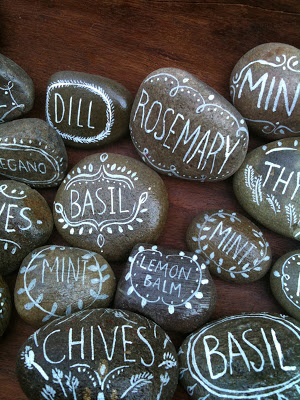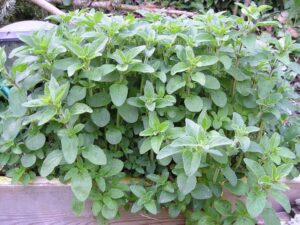Cool Season Herbs
Parsley, Sage, Rosemary and Thyme . . . and More
by Janet Scheren, Fairfax Master Gardener
 When I hear the old English ballad Scarborough Fair, refreshed in modern times by Simon and Garfunkel, I visualize a medieval harvest feast. Completing this picture are the savory herbs regaled in the song–parsley, sage, rosemary and thyme–paired with the roast fowl, beef or game. It’s no surprise these herbs have become the flavors the Western world associates with special fall and winter celebrations. These herbs and several others persevere in our gardens long after the likes of basil, summer savory and marjoram have succumbed to the nips of cold air. Many of these hardy herbs survive frost and remain useful stalwarts in our winter gardens well into spring.
When I hear the old English ballad Scarborough Fair, refreshed in modern times by Simon and Garfunkel, I visualize a medieval harvest feast. Completing this picture are the savory herbs regaled in the song–parsley, sage, rosemary and thyme–paired with the roast fowl, beef or game. It’s no surprise these herbs have become the flavors the Western world associates with special fall and winter celebrations. These herbs and several others persevere in our gardens long after the likes of basil, summer savory and marjoram have succumbed to the nips of cold air. Many of these hardy herbs survive frost and remain useful stalwarts in our winter gardens well into spring.
Other herbs that survive our typical Zone 7 winter include oregano, lavender, cilantro, chervil, chives, and dill, catnip, sorrel, caraway, lemon balm, tarragon and horseradish. That means that they regrow again in spring, but it does not necessarily remain viable to harvest in snow and sub-freezing temperatures.
Sow cool weather herbs directly in the garden a month or more before the last frost in spring for late spring harvest — well before the stress of summer heat kicks in causing them to bolt and go to seed. When this happens, the herbs turn bitter. To speed the germination of cool-season herbs soak them overnight in water before sowing. Then cover the seedbed with clear plastic to help warm the soil. Plant them again late summer for a bumper fall harvest. Providing a thick layer of mulch can help protect these herbs during the winter.

Sage
Parsley
This is a hardy biennial herb that is commonly grown as an annual. It sprouts a nice crop of leaves during the first year, then comes back even bigger and better the second year. However, during its second and final year, it flowers and sets seeds. While it loses flavor during year two, it’s worth keeping around. Its flowers resemble dill blossoms and attract a bevy of bees and other beneficial pollinators. It also serves as the host plant for the Black Swallowtail. Direct sow seeds or set out six- to eight-week-old transplants about a week before the last frost in spring. Where winters are mild, parsley can be sown in late winter. Parsley seeds are slow to germinate, so you’ll want to soak them or freeze them overnight before sowing. Parsley can grow in full sun or partial shade. For culinary purposes, select Italian parsley with its celery and cilantro-like leaves. Harvest the outer leaves or cut the whole plant down to a couple of inches above the soil and it will regrow.
Sage
This herb is an evergreen member of the Salvia family. Most of the many varieties and flavors of sages are hardy perennials. In temperate areas, they survive winter weather without protection unless an ice storm hits. Sage can also be grown in containers and brought indoors during the coldest months of the year. The rest of the year, give sage a sunny spot in well-drained soil.
Rosemary
Rosemary has a piney flavor that is a perfect addition to poultry, potatoes, stews and even some crackers and cookies. Despite its Mediterranean origins, this hardy evergreen adapts well to any situation except full shade or soggy soil. Established shrubs withstand tough winters, but smaller plants should be covered with a frost barrier when the temperatures drop. Rosemary also grows well in containers and can be brought inside for the winter. Try the Arp variety to beat winter kill.

Thyme
Thyme
The pungent scent of thyme comes from the oil in the small oval leaves of this popular herb. It thrives in full sun and dry conditions and is hardy to Zone 5. Grow it in sandy or loamy soil and be careful not to overwater. This herb can also grow in rocky gravel. There are many wonderful varieties including lemon thyme and others with variegated foliage. Be careful not to harvest more than one-third of the plant.
Other Cool Season Herbs to Consider
Bay laurel
This is a small evergreen tree. Its leaves are widely used in seasoning soups and other savory dishes. While mature laurel plants are hardy down to about 0 °F, young plants are not. As such, they are often grown in containers that are taken in for the winter to sit on a sunny windowsill. Bay laurel thrives in sun to partial shade and moist soil. The leaves can be used either fresh or dried.
Chives
These are a cold-hardy perennial member of the onion family. They are easily grown in full sun from seeds, transplants or divisions. Their grass-like dark green leaves, which grow to about 12 inches tall, are often chopped and used in salads or as garnish on savory dishes. If left untrimmed, they sport showy lavender flowers that are edible themselves and make a nice garnish for salads. Sow seeds or set out well established seedlings about four weeks before the last frost in spring. Divide clumps every two to four years in spring or fall. Onion chives have a delicate onion flavor. Garlic chives have a mild garlic flavor. They can be brought inside the house in late autumn to grace the kitchen windowsill.
Cilantro
This is a cold-hardy annual herb. Sow these seeds a week or two before the last frost in spring. One of the first blooms in the garden, they provide much needed support for pollinators as they forage for food in late spring. For best germination, soak seeds in water overnight before sowing. Cilantro seeds are known as coriander and have a citrus and spice flavor. When the weather gets too hot, expect this herb to bolt (flower and go to seed). Its leaves have a parsley-sage-citrus flavor that is common in Latin and Southeast Asian dishes such as curries, salsas, salads, chutneys and guacamole.
Dill
Dill is one of the easiest herbs to grow from seed sown in fall or early spring. It also freely self-seeds in subsequent years. At the onset of hot weather, dill starts to go to seed. Feathery young leaves are used in salads and with vegetables and fish. The ripe seeds and unripe seed heads are used in pickling. Dill is an important food source for swallowtail butterfly larvae. Do not plant dill near fennel since they can cross and produce strangely flavored seedlings. Sow dill in the garden four to five weeks before the last frost in spring. Seeds require light to germinate. Dill can also be sown in fall in mild winter temperatures regions.

Oregano leaves
Mints
These are a very large group of herbs with many species and cultivars in a wide range of flavors. Most have several traits in common. They are easy, vigorous growers that can become invasive if not confined. All prefer to grow in rich, moist or even damp soil in part shade. It is best to grow mints from cuttings, roots or transplants. Harvest leaves frequently to encourage best growth and prevent flowering because mint seed does not come true to type.
Oregano
This herb is a hardy perennial and does well in containers. It grows to 2 feet tall, with small rounded leaves and pale pink flowers. Plant oregano in full sun and well-drained soil. Greek oregano (Origanum heracleoticum) is highly prized for its sharp, biting oregano taste. Oregano is a woody perennial plant that’s a member of the mint family.
References
Herbs, Factsheet HGIC 1311, Updated: 2019, Clemson Cooperative Extension
Winterizing the Herb Garden, Jeanine Davis, NC State Extension